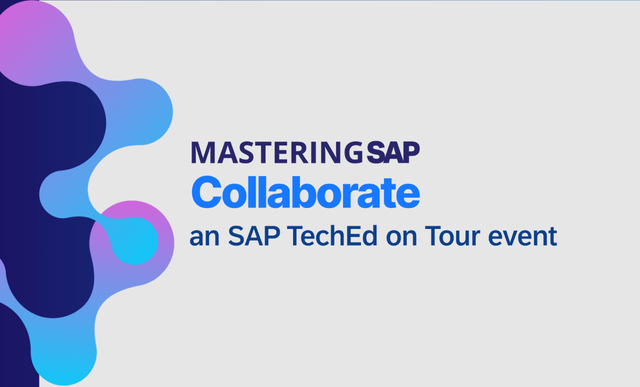SAP Risk Analysis
Filter By
Browse By
- SAP Analytics and AI
- SAP Application Development and Integration
- All SAP Application Development and Integration
- SAP ABAP
- SAP ABAP Development Tools
- SAP ABAP Test Cockpit
- SAP API Management
- SAP BAPI
- SAP Basis
- SAP BRF
- SAP Business Application Studio
- SAP CMS
- SAP Design Studio
- SAP Development Tools
- SAP DevOps
- SAP EAI
- SAP EDI
- SAP Extension Suite
- SAP Fiori
- SAP Fiori Elements
- SAP Integration Suite
- SAP Low Code Application Development
- SAP Low Code Automation
- SAP Netweaver
- SAP Release Management
- SAP UI5
- SAP Web Application Server
- SAP Web IDE
- SAP Business Process Management
- SAP Center of Excellence
- SAP CIO
- SAP Customer Experience
- SAP Data and Data Management
- All SAP Data and Data Management
- SAP BW
- SAP BW/4HANA
- SAP Crystal Reports
- SAP Data Archiving
- SAP Data Center
- SAP Data Governance
- SAP Data Integration
- SAP Data Migration
- SAP Data Quality
- SAP Data Services
- SAP Data Strategy
- SAP Data Visualization
- SAP Data Warehouse Cloud
- SAP DMS
- SAP Document Control
- SAP EIM
- SAP ETL
- SAP ETL Tools
- SAP HANA
- SAP HANA Administration
- SAP HANA Deployment Infrastructure
- SAP HANA Studio
- SAP Master Data
- SAP Master Data Governance
- SAP MDM
- SAP Enterprise Architect
- SAP Enterprise Asset Management
- SAP ERP
- SAP Finance
- All SAP Finance
- SAP Accounting
- SAP AR AP
- SAP Asset Accounting
- SAP Billing Systems
- SAP BPC
- SAP BRIM
- SAP Cash Management
- SAP Central Finance
- SAP Controlling
- SAP COPA
- SAP Cost Center Accounting
- SAP Currency Risk
- SAP e-invoicing
- SAP FICO
- SAP Finance Automation
- SAP Advanced Financial Closing
- SAP Financial Consolidation
- SAP Financial Planning
- SAP FX Risk
- SAP General Ledger
- SAP Global Tax Management
- SAP Hyperion
- SAP Order to Cash
- SAP Payment Processing
- SAP Profitability Analysis
- SAP Rebate Management
- SAP S/4HANA Finance
- SAP SWIFT Compliance
- SAP Treasury Management
- SAP Universal Journal
- SAP Governance Risk and Compliance
- SAP Human Capital Management
- SAP Intelligent Technologies
- SAP Platform and Technology
- All SAP Platform and Technology
- SAP Business Technology Platform
- SAP Cloud
- SAP Cloud Connector
- SAP Cloud Integration Platform
- SAP Cloud Migration
- SAP Cloud Platform
- SAP Cloud Providers
- SAP Cloud Strategy
- SAP Digital Signature
- SAP Container Platform
- SAP HANA Enterprise Cloud
- SAP Digital Asset Management
- SAP Smart Forms
- SAP HEC
- SAP Digital Integration Hub
- SAP Hyperscalers
- SAP Infrastructure
- SAP Messaging
- SAP Quality and Testing
- SAP Security
- SAP Spend Management
- SAP Supply Chain Management
- All SAP Supply Chain Management
- SAP APO
- SAP Asset Management
- SAP Business Network
- SAP Digital Manufacturing Cloud
- SAP Digital Twin
- SAP EWM
- SAP IBP
- SAP Inventory Management
- SAP Label Printing
- SAP Logistics
- SAP Manufacturing
- SAP Manufacturing Automation
- SAP MES
- SAP MII
- SAP MM
- SAP MRO
- SAP MRP
- SAP Order Management
- SAP Plant Maintenance
- SAP PLM
- SAP Production Planning
- SAP S&OP
- SAP SD
- SAP SPM
- SAP Supply Chain Planning
- SAP Track and Trace
- SAP Transportation Management
- SAP System Administration
What Is Risk Analysis?
Risk analysis is the assessment of potential risks on the business or market and the likelihood of adverse effects from those events. In a supply chain context, for example, companies model various disruptions to determine their impact and apply risk mitigation strategies to avoid them.
According to Investopedia, risk analysis can be divided between two types: qualitative and quantitative.
Qualitative analysis: Qualitative analysis incorporates a definition of uncertainties, evaluation of the potential impacts, and risk mitigation measures. Examples include SWOT analysis and cause and effect diagrams.
Quantitative analysis: Quantitative analysis relies on statistical modeling and assigning numeric values to potential risks. Within a risk model, those values produce graphical outputs to help determine risk mitigation strategies.
Through both risk analysis approaches, companies can glean an holistic view of their risk profile.
What Is Risk Analysis?
Risk analysis is the assessment of potential risks on the business or market and the likelihood of adverse effects from those events. In a supply chain context, for example, companies model various disruptions to determine their impact and apply risk mitigation strategies to avoid them.
According to Investopedia, risk analysis can be divided between two types: qualitative and quantitative.
Qualitative analysis: Qualitative analysis incorporates a definition of uncertainties, evaluation of the potential impacts, and risk mitigation measures. Examples include SWOT analysis and cause and effect diagrams.
Quantitative analysis: Quantitative analysis relies on statistical modeling and assigning numeric values to potential risks. Within a risk model, those values produce graphical outputs to help determine risk mitigation strategies.
Through both risk analysis approaches, companies can glean an holistic view of their risk profile.
SAP and Risk Management
As more companies migrate to SAP S/4HANA, it’s critical that their risk strategies are integrated within the system. SAP provides risk management solutions that put governance, risk, and compliance at the forefront of business activities.
According to SAP, “stakeholders want to see evidence, on demand and in real time, that an organization which they are backing is managing their financial, social, and environmental activities efficiently, profitably, and responsibly … Any risk management measures must focus on the specific value drivers unique to the business, and these can be difficult for you to identify. Managers must look beyond financial line items to the activities and processes that are integral to the organization’s business model.”
Further Resources for SAPinsiders
Building More Effective Access Control Through Business-Centric GRC. In this article, learn how companies are utilizing access control solutions to identify risk within their user base. These solutions and processes are often technical and driven from audit and IT perspectives with very little input from business users who might find the technical GRC language hard to decipher. That’s where the idea of business-centric GRC comes into play for access control — providing the business with easier to understand, less technical language so that they can better interpret the data.
Application Security Imperiled by Attackers. Application security is being threatened by cyberattacks on the application layer, such as SAP S/4HANA systems, which target valuable resources organizations store there. In this article, learn about new security concepts necessary to protect the “crown jewels” stored in SAP systems. Companies need to deploy real-time detection and response to deal with the rise in attacks against the SAP application layer level.
Vendors that can help SAP customers with risk analysis include: Appsian Security, DXC Technology, EcoVadis, and Onapsis.
831 results
-

- SAP EDI
 Premium
Premium
SAP BusinessObjects Analysis, OLAP Edition — BEx and Voyager Combined
Reading time: 9 mins
Find out how you can use the newly released SAP BusinessObjects Analysis, OLAP Edition as part of your overall SAP BusinessObjects 4.0 release. SAP BusinessObjects Analysis, OLAP Edition is the counterpart for SAP BusinessObjects Analysis, edition for Microsoft Office for Web-based deployments. Key Concept SAP BusinessObjects Analysis, OLAP Edition is the successor to SAP BusinessObjects...…
-

 Premium
Premium
How to Use SAP HANA’s Analytics and Text Analysis Capabilities
Reading time: 9 mins
See how to apply the SAP HANA analytics and text analysis feature on raw data to solve critical problems. Learn how to use text analytics to gain insight into content-specific values, such as emotions, sentiments, and relevance. Key Concept SAP HANA provides a single platform to extract and analyze massive amounts of structured and unstructured...…
-

- SAP Access Control
 Premium
Premium
Manage Invalid Mitigations in SAP Access Control 10.1
Reading time: 9 mins
Learn about the different aspects and flexibility of risk mitigations in SAP Access Control 10.1. Access risk mitigation is used to mitigate access risk violations. It is applicable for all types of risks for different objects such as users, roles, profiles, and HR objects (job, org unit, and position) in SAP Access Control. Access risk...…
-
-

 Premium
Premium
Analyze the Impact of SAP Software Changes on Your Business Processes
Reading time: 22 mins
ManagerSee how to achieve a risk-based test scope identification using Business Process Change Analyzer in SAP Solution Manager 7.0 EhP1 (Enterprise Edition). It allows you to analyze the impact of software changes triggered by SAP Support Packages, customizing changes, or custom code development on your important business processes. Key Concept Business Process Change Analyzer provides...…
-

 Premium
Premium
A Guide to End-to-End Root Cause Analysis
Reading time: 18 mins
ManagerLearn how to set up and use SAP Solution Manager Root Cause Analysis and Wily Introscope Enterprise Manager. Key Concept End-to-End Root Cause Analysis offers systematic analysis and resolution of incidents for a distributed environment. End-to-End (E2E) Root Cause Analysis is part of SAP Solution Manager and uses SAP NetWeaver Business Warehouse (SAP NetWeaver BW)...…
-

 Premium
Premium
How to Use Formula Mode for Complex Analysis
Reading time: 19 mins
Learn how to use an often-overlooked feature of the Excel-based reporting toolbox: formula mode. Learn why formula mode makes SAP BW’s BEx Analyzer and BusinessObjects Analysis the preferred tools for heavy analysis users. Key Concept Formula mode, a feature in BW’s BEx Analyzer and BusinessObjects Analysis for Excel, takes an SAP BW data stream and...…
-

How to Manage Enterprise Risk in Remote and Digital Environments
Reading time: 12 mins
As organizations migrate to SAP S/4HANA as part of their digital transformation effort, they should prioritize governance, risk, and compliance (GRC). The Institute of Internal Auditors (IIA) has developed a Three Lines Model to help with that journey. First-line roles include operation and support functions; second-line roles encompass corporate risk, compliance, and quality assurance functions;…
-
-

 Premium
Premium
Best Practices for Configuring the Solution Documentation Assistant
Reading time: 10 mins
ManagerLearn how to configure the Solution Documentation Assistant in SAP Solution Manager to analyze your entire system landscape and provide a detailed report. This functionality is useful if an upgrade needs to be executed in a short span of time, because you can create an SAP Solution Manager project from that report. Key Concept The...…
-

- SAP Access Control
 Premium
Premium
SAP Access Control Implementation: The Myths, Truths, and Tricks (Part 2)
Reading time: 21 mins
Correct certain assumptions about the SAP Access Control system that are not necessarily true and obtain guidance on how to meet specific complex business requirements during an implementation project, including maintenance and support activities. Key Concept Myth is often the result of wishful thinking about the capability of a product that most times is unfounded....…
-

 Premium
Premium
When to Use Organization Rules and Reporting in Compliance Calibrator
Reading time: 12 mins
Find out if your company should use organization rules for eliminating false positives from reports. Key Concept You use organization rules to provide an additional layer of segregation of duties (SoD) analysis to remove false positives that may result from segregating based on organization levels. You perform this analysis on top of your core Compliance...…
Become a Member
Unlimited access to thousands of resources for SAP-specific expertise that can only be found here.
Become a Partner
Access exclusive SAP insights, expert marketing strategies, and high-value services including research reports, webinars, and buyers' guides, all designed to boost your campaign ROI by up to 50% within the SAP ecosystem.
Upcoming Events
-

Mastering SAP Collaborate, an SAP TechEd on Tour event
November 12 - 14, 2025
Sydney, New South Wales
Australia
View Event
Related Vendors
Your request has been successfully sent

